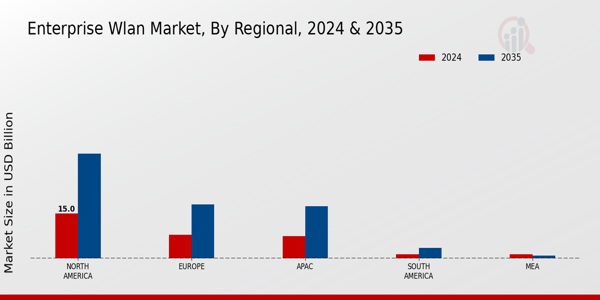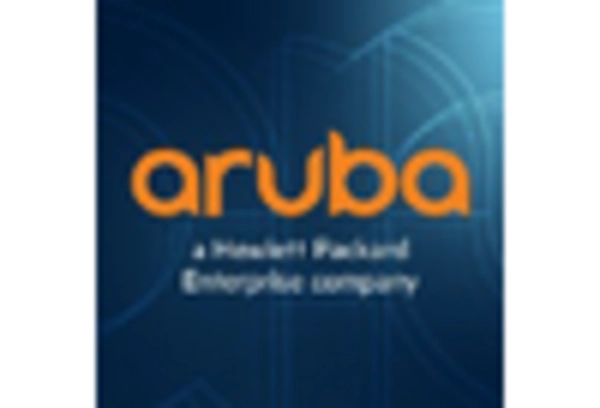Emergence of 5G Technology
The advent of 5G technology is poised to revolutionize the Enterprise WLAN Market. With its promise of ultra-fast data speeds and low latency, 5G is expected to enhance wireless connectivity for enterprises significantly. This technology enables organizations to deploy more advanced applications and services, thereby driving the need for upgraded WLAN infrastructure. Analysts predict that the integration of 5G with existing WLAN systems could lead to a market expansion of approximately 15% by 2025. As enterprises seek to leverage the benefits of 5G, the Enterprise WLAN Market is likely to witness increased investments in next-generation wireless solutions that can support this transformative technology.
Growing Adoption of IoT Devices
The proliferation of Internet of Things (IoT) devices is a key driver in the Enterprise WLAN Market. As organizations increasingly integrate IoT solutions into their operations, the demand for robust wireless networks escalates. It is estimated that by 2025, the number of connected IoT devices could reach 75 billion, necessitating advanced WLAN infrastructure to support seamless connectivity. This trend compels enterprises to upgrade their WLAN systems to accommodate the influx of devices, ensuring reliable performance and security. Consequently, the Enterprise WLAN Market is witnessing a surge in demand for scalable and high-capacity wireless solutions that can handle the complexities of IoT environments.
Shift Towards Remote Work Solutions
The transition to remote work has fundamentally altered the landscape of the Enterprise WLAN Market. Organizations are increasingly investing in wireless solutions that facilitate remote access and collaboration among distributed teams. This shift has led to a projected increase in WLAN spending, with estimates suggesting a growth rate of approximately 10% annually through 2025. Enterprises are prioritizing the deployment of secure and efficient WLAN systems that can support remote work while maintaining productivity. As a result, the Enterprise WLAN Market is adapting to meet the evolving needs of businesses seeking to enhance their remote work capabilities.
Demand for Enhanced Network Security
In an era where cyber threats are becoming more sophisticated, the demand for enhanced network security is a critical driver in the Enterprise WLAN Market. Organizations are increasingly aware of the vulnerabilities associated with wireless networks and are investing in advanced security measures. The market for WLAN security solutions is expected to grow significantly, with projections indicating a compound annual growth rate of around 12% through 2025. This trend underscores the necessity for enterprises to implement robust security protocols, such as encryption and authentication, to safeguard sensitive data. Consequently, the Enterprise WLAN Market is evolving to incorporate innovative security features that address these pressing concerns.
Rising Need for Scalability and Flexibility
The increasing complexity of business operations necessitates a rising need for scalability and flexibility in the Enterprise WLAN Market. Organizations are seeking WLAN solutions that can easily adapt to changing demands, such as fluctuating user loads and varying application requirements. This trend is particularly evident in sectors like retail and healthcare, where dynamic environments require agile wireless networks. Market forecasts suggest that the demand for scalable WLAN solutions will grow by approximately 8% annually through 2025. As enterprises prioritize flexibility in their wireless infrastructure, the Enterprise WLAN Market is responding by offering innovative solutions that cater to these evolving needs.


















Leave a Comment